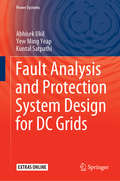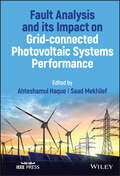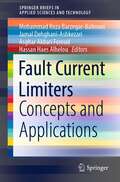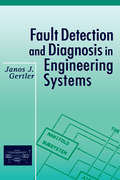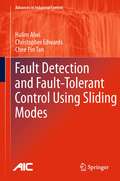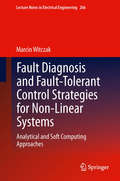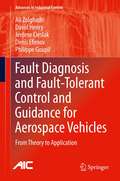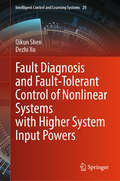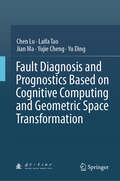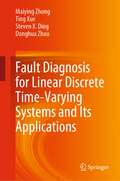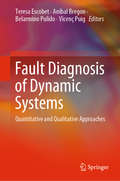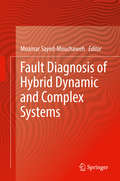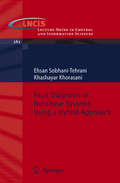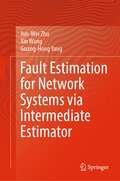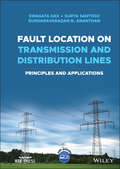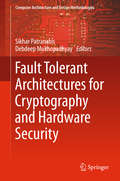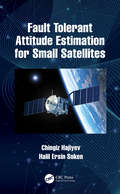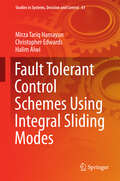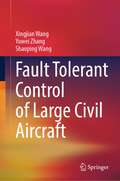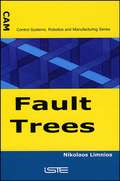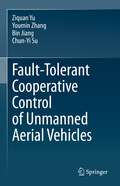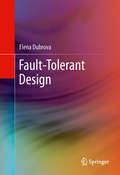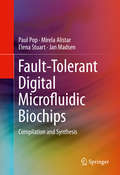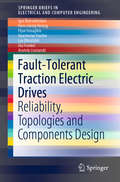- Table View
- List View
Fault Analysis and Protection System Design for DC Grids (Power Systems)
by Abhisek Ukil Yew Ming Yeap Kuntal SatpathiThis book offers a comprehensive reference guide to the important topics of fault analysis and protection system design for DC grids, at various voltage levels and for a range of applications. It bridges a much-needed research gap to enable wide-scale implementation of energy-efficient DC grids. Following an introduction, DC grid architecture is presented, covering the devices, operation and control methods. In turn, analytical methods for DC fault analysis are presented for different types of faults, followed by separate chapters on various DC fault identification methods, using time, frequency and time-frequency domain analyses of the DC current and voltage signals. The unit and non-unit protection strategies are discussed in detail, while a dedicated chapter addresses DC fault isolation devices. Step-by-step guidelines are provided for building hardware-based experimental test setups, as well as methods for validating the various algorithms. The book also features several application-driven case studies.
Fault Analysis and its Impact on Grid-connected Photovoltaic Systems Performance
by Saad Mekhilef Ahteshamul HaqueFault Analysis and its Impact on Grid-connected Photovoltaic Systems Performance A thorough and authoritative discussion of how to use fault analysis to prevent grid failures In Fault Analysis and its Impact on Grid-connected Photovoltaic Systems Performance, a team of distinguished engineers deliver an insightful and concise analysis on how engineers can use fault analysis to estimate and ensure reliability in grid-connected photovoltaic systems. The editors explore how failure data can be used to identify how power electronics-based power systems operate and how they can help to perform risk analysis and reduce the likelihood and frequency of failure. The book explains how to apply different fault detection techniques—including signal and image processing, fault tolerant approaches—and explores the impact of faults in grid-connected photovoltaic systems. It offers contributions from noted experts in the field and is fully updated to include the latest technologies and approaches. Readers will also find: A failure mode effect classification approach for distributed generation systems and their components Explanations of advanced machine learning approaches with significant market potential and real-world relevance A consideration of the issues pertaining to the integration of power electronics converters with distributed generation systems in grid-connected environments Treatments of IoT-based monitoring, ageing detection for capacitors, image and signal processing approaches, and standards for failure modes and criticality analyses Perfect for manufacturers and engineers working in the power electronics-based power system and smart grid sectors, Fault Analysis and its Impact on Grid- connected Photovoltaic Systems Performance will also earn a place in the libraries of distributed generation companies facing issues in operation and maintenance.
Fault Current Limiters: Concepts and Applications (SpringerBriefs in Applied Sciences and Technology)
by Hassan Haes Alhelou Mohammad Reza Barzegar-Bafrooei Jamal Dehghani-Ashkezari Asghar Akbari ForoudThis book presents a comprehensive survey of fault current limiters (FCLs) and their applications in power system to cope with the fault current. The book reviews characteristics, technologies, topologies, working principles, applications, and the interaction of FCLs with the power system. In the attempts to develop FCL with close to ideal attributes, academic researchers and companies offer the different configurations that are mostly classified into non-superconducting fault current limiters and superconducting fault current limiters (SFCLs). Both categories are included in this book, and therefore, it can serve as an excellent stepping-stone for senior and/or graduate students who are interested in knowing the reason of the increase in short circuit level in the power system, fault current limitation measures, benefits and drawbacks of the application of FCLs in power systems, the state-of-the-art of fault current limitation techniques, as well as recent advances in this area.
Fault Detection and Diagnosis in Engineering Systems
by Janos GertlerFeaturing a model-based approach to fault detection and diagnosis in engineering systems, this book contains up-to-date, practical information on preventing product deterioration, performance degradation and major machinery damage.;College or university bookstores may order five or more copies at a special student price. Price is available upon request.
Fault Detection and Fault-Tolerant Control Using Sliding Modes
by Halim Alwi Christopher Edwards Chee Pin TanFault Detection and Fault-tolerant Control Using Sliding Modes is the first text dedicated to showing the latest developments in the use of sliding-mode concepts for fault detection and isolation (FDI) and fault-tolerant control in dynamical engineering systems. It begins with an introduction to the basic concepts of sliding modes to provide a background to the field. This is followed by chapters that describe the use and design of sliding-mode observers for FDI using robust fault reconstruction. The development of a class of sliding-mode observers is described from first principles through to the latest schemes that circumvent minimum-phase and relative-degree conditions. Recent developments have shown that the field of fault tolerant control is a natural application of the well-known robustness properties of sliding-mode control. A family of sliding-mode control designs incorporating control allocation, which can deal with actuator failures directly by exploiting redundancy, is presented. Various realistic case studies, specifically highlighting aircraft systems and including results from the implementation of these designs on a motion flight simulator, are described. A reference and guide for researchers in fault detection and fault-tolerant control, this book will also be of interest to graduate students working with nonlinear systems and with sliding modes in particular. Advances in Industrial Control aims to report and encourage the transfer of technology in control engineering. The rapid development of control technology has an impact on all areas of the control discipline. The series offers an opportunity for researchers to present an extended exposition of new work in all aspects of industrial control.
Fault Diagnosis and Fault-Tolerant Control Strategies for Non-Linear Systems
by Marcin WitczakThis book presents selected fault diagnosis and fault-tolerant control strategies for non-linear systems in a unified framework. In particular, starting from advanced state estimation strategies up to modern soft computing, the discrete-time description of the system is employed Part I of the book presents original research results regarding state estimation and neural networks for robust fault diagnosis. Part II is devoted to the presentation of integrated fault diagnosis and fault-tolerant systems. It starts with a general fault-tolerant control framework, which is then extended by introducing robustness with respect to various uncertainties. Finally, it is shown how to implement the proposed framework for fuzzy systems described by the well-known Takagi-Sugeno models. This research monograph is intended for researchers, engineers, and advanced postgraduate students in control and electrical engineering, computer science, as well as mechanical and chemical engineering.
Fault Diagnosis and Fault-Tolerant Control and Guidance for Aerospace Vehicles
by David Henry Ali Zolghadri Jérôme Cieslak Denis Efimov Philippe GoupilFault Diagnosis and Fault-Tolerant Control and Guidance for Aerospace demonstrates the attractive potential of recent developments in control for resolving such issues as flight performance, self protection and extended-life structures. Importantly, the text deals with a number of practically significant considerations: tuning, complexity of design, real-time capability, evaluation of worst-case performance, robustness in harsh environments, and extensibility when development or adaptation is required. Coverage of such issues helps to draw the advanced concepts arising from academic research back towards the technological concerns of industry. Initial coverage of basic definitions and ideas and a literature review gives way to a treatment of electrical flight control system failures: oscillatory failure, runaway, and jamming. Advanced fault detection and diagnosis for linear and linear-parameter-varying systems are described. Lastly recovery strategies appropriate to remaining actuator/sensor/communications resources are developed. The authors exploit experience gained in research collaboration with academic and major industrial partners to validate advanced fault diagnosis and fault-tolerant control techniques with realistic benchmarks or real-world aeronautical and space systems. Consequently, the results presented in Fault Diagnosis and Fault-Tolerant Control and Guidance for Aerospace, will be of interest in both academic and aerospatial-industrial milieux.
Fault Diagnosis and Fault-Tolerant Control of Nonlinear Systems with Higher System Input Powers (Intelligent Control and Learning Systems #20)
by Qikun Shen Dezhi XuThis book provides recent theoretical results and applications of the fault diagnosis and fault-tolerant control for the nonlinear systems with higher input powers. Combining adaptive control technique, fuzzy logic systems, neural networks, Observer-based methods with the other control technique or approaches, this book investigates the fault diagnosis and fault-tolerant control problem of the nonlinear systems with higher input powers and proposes the corresponding diagnostic mechanisms, Fault estimation algorithm and fault-tolerant control schemes. This book intends to provide the readers a good understanding on fault diagnosis and fault-tolerant control of the nonlinear systems with higher input powers based on adaptive control technology. This book can serve as a reference for the main research issues and results on nonlinear systems with higher input powers for researchers devoting to various areas of fault-tolerant control theory, as well as a material for graduate and undergraduate students interested in nonlinear system control, especially fault diagnosis and fault-tolerant control, and their applications. Some prerequisites for reading this book include nonlinear system theory, matrix theory, mathematics, basic graph theory, and so on.
Fault Diagnosis and Prognostics Based on Cognitive Computing and Geometric Space Transformation
by Jian Ma Yu Ding Chen Lu Laifa Tao Yujie ChengThis monograph introduces readers to new theories and methods applying cognitive computing and geometric space transformation to the field of fault diagnosis and prognostics. It summarizes the basic concepts and technical aspects of fault diagnosis and prognostics technology. Existing bottleneck problems are examined, and the advantages of applying cognitive computing and geometric space transformation are explained. In turn, the book highlights fault diagnosis, prognostic, and health assessment technologies based on cognitive computing methods, including deep learning, transfer learning, visual cognition, and compressed sensing. Lastly, it covers technologies based on differential geometry, space transformation, and pattern recognition.
Fault Diagnosis for Linear Discrete Time-Varying Systems and Its Applications
by Steven X. Ding Donghua Zhou Maiying Zhong Ting XueThis book focuses on fault diagnosis for linear discrete time-varying (LDTV) systems and its applications in modern engineering processes, with more weighting placed on the development of theory and methodologies. A comprehensive and systematic study on fault diagnosis for LDTV systems is provided, covering H∞-optimization-based fault diagnosis, H∞-filtering-based fault diagnosis, parity space-based fault diagnosis, Krein space technique-aided fault detection and fault estimation, and their typical applications in linear/nonlinear processes such as satellite attitude control systems and INS/GPS systems. This book benefits researchers, engineers, and graduate students in the fields of control engineering, electrical and electronic engineering, instrumentation science, and optoelectronic engineering.
Fault Diagnosis of Dynamic Systems: Quantitative and Qualitative Approaches
by Vicenç Puig Teresa Escobet Anibal Bregon Belarmino PulidoFault Diagnosis of Dynamic Systems provides readers with a glimpse into the fundamental issues and techniques of fault diagnosis used by Automatic Control (FDI) and Artificial Intelligence (DX) research communities. The book reviews the standard techniques and approaches widely used in both communities. It also contains benchmark examples and case studies that demonstrate how the same problem can be solved using the presented approaches. The book also introduces advanced fault diagnosis approaches that are currently still being researched, including methods for non-linear, hybrid, discrete-event and software/business systems, as well as, an introduction to prognosis.Fault Diagnosis of Dynamic Systems is valuable source of information for researchers and engineers starting to work on fault diagnosis and willing to have a reference guide on the main concepts and standard approaches on fault diagnosis. Readers with experience on one of the two main communities will also find it useful to learn the fundamental concepts of the other community and the synergies between them. The book is also open to researchers or academics who are already familiar with the standard approaches, since they will find a collection of advanced approaches with more specific and advanced topics or with application to different domains. Finally, engineers and researchers looking for transferable fault diagnosis methods will also find useful insights in the book.
Fault Diagnosis of Hybrid Dynamic and Complex Systems
by Moamar Sayed-MouchawehOnline fault diagnosis is crucial to ensure safe operation of complex dynamic systems in spite of faults affecting the system behaviors. Consequences of the occurrence of faults can be severe and result in human casualties, environmentally harmful emissions, high repair costs, and economical losses caused by unexpected stops in production lines. The majority of real systems are hybrid dynamic systems (HDS). In HDS, the dynamical behaviors evolve continuously with time according to the discrete mode (configuration) in which the system is. Consequently, fault diagnosis approaches must take into account both discrete and continuous dynamics as well as the interactions between them in order to perform correct fault diagnosis. This book presents recent and advanced approaches and techniques that address the complex problem of fault diagnosis of hybrid dynamic and complex systems using different model-based and data-driven approaches in different application domains (inductor motors, chemical process formed by tanks, reactors and valves, ignition engine, sewer networks, mobile robots, planetary rover prototype etc.). These approaches cover the different aspects of performing single/multiple online/offline parametric/discrete abrupt/tear and wear fault diagnosis in incremental/non-incremental manner, using different modeling tools (hybrid automata, hybrid Petri nets, hybrid bond graphs, extended Kalman filter etc.) for different classes of hybrid dynamic and complex systems.
Fault Diagnosis of Nonlinear Systems Using a Hybrid Approach
by Khashayar Khorasani Ehsan Sobhani-TehraniThere is an increasing demand for man-made dynamical systems to operate autonomously in the presence of faults and failures in sensors, actuators or components. Fault diagnosis and health monitoring are essential components of an autonomous system. Hence, a high demand exists for the development of intelligent systems that are able to autonomously detect the presence and isolate the location of faults occurring in different components of complex dynamical systems. Fault Diagnosis of Nonlinear Systems Using A Hybrid Approach focuses on developing a fault diagnosis methodology that enables on-line health monitoring of nonlinear systems and off-line monitoring purposes.
Fault Diagnosis, Prognosis, and Reliability for Electrical Machines and Drives (IEEE Press)
by Hubert Razik Abdenour Soualhi Elias G. Strangas Guy ClercFault Diagnosis, Prognosis, and Reliability for Electrical Machines and Drives An insightful treatment of present and emerging technologies in fault diagnosis and failure prognosis In Fault Diagnosis, Prognosis, and Reliability for Electrical Machines and Drives, a team of distinguished researchers delivers a comprehensive exploration of current and emerging approaches to fault diagnosis and failure prognosis of electrical machines and drives. The authors begin with foundational background, describing the physics of failure, the motor and drive designs and components that affect failure and signals, signal processing, and analysis. The book then moves on to describe the features of these signals and the methods commonly used to extract these features to diagnose the health of a motor or drive, as well as the methods used to identify the state of health and differentiate between possible faults or their severity. Fault Diagnosis, Prognosis, and Reliability for Electrical Machines and Drives discusses the tools used to recognize trends towards failure and the estimation of remaining useful life. It addresses the relationships between fault diagnosis, failure prognosis, and fault mitigation. The book also provides: A thorough introduction to the modes of failure, how early failure precursors manifest themselves in signals, and how features extracted from these signals are processed A comprehensive exploration of the fault diagnosis, the results of characterization, and how they used to predict the time of failure and the confidence interval associated with it A focus on medium-sized drives, including induction, permanent magnet AC, reluctance, and new machine and drive types Perfect for researchers and students who wish to study or practice in the rea of electrical machines and drives, Fault Diagnosis, Prognosis, and Reliability for Electrical Machines and Drives is also an indispensable resource for researchers with a background in signal processing or statistics.
Fault Estimation for Network Systems via Intermediate Estimator
by Xin Wang Guang-Hong Yang Jun-Wei ZhuThis book is concerned with the fault estimation problem for network systems. Firstly, to improve the existing adaptive fault estimation observer, a novel so-called intermediate estimator is proposed to identify the actuator or sensor faults in dynamic control systems with high accuracy and convergence speed. On this basis, by exploiting the properties of network systems such as multi-agent systems and large-scale interconnected systems, this book introduces the concept of distributed intermediate estimator; faults in different nodes can be estimated simultaneously; meanwhile, satisfactory consensus performances can be obtained via compensation based protocols. Finally, the characteristics of the new fault estimation methodology are verified and discussed by a series of experimental results on networked multi-axis motion control systems. This book can be used as a reference book for researcher and designer in the field of fault diagnosis and fault-tolerant control and can also be used as a reference book for senior undergraduate and graduate students in colleges and universities.
Fault Location on Transmission and Distribution Lines: Principles and Applications (IEEE Press)
by Swagata Das Surya Santoso Sundaravaradan N. AnanthanThis book provides readers with up-to-date coverage of fault location algorithms in transmission and distribution networks. The algorithms will help readers track down the exact location of a fault in the shortest possible time. Furthermore, voltage and current waveforms recorded by digital relays, digital fault recorders, and other intelligent electronic devices contain a wealth of information. Knowledge gained from analysing the fault data can help system operators understand what happened, why it happened and how it can be prevented from happening again. The book will help readers convert such raw data into useful information and improve power system performance and reliability.
Fault Tolerant Architectures for Cryptography and Hardware Security (Computer Architecture and Design Methodologies)
by Debdeep Mukhopadhyay Sikhar PatranabisThis book uses motivating examples and real-life attack scenarios to introduce readers to the general concept of fault attacks in cryptography. It offers insights into how the fault tolerance theories developed in the book can actually be implemented, with a particular focus on a wide spectrum of fault models and practical fault injection techniques, ranging from simple, low-cost techniques to high-end equipment-based methods. It then individually examines fault attack vulnerabilities in symmetric, asymmetric and authenticated encryption systems. This is followed by extensive coverage of countermeasure techniques and fault tolerant architectures that attempt to thwart such vulnerabilities. Lastly, it presents a case study of a comprehensive FPGA-based fault tolerant architecture for AES-128, which brings together of a number of the fault tolerance techniques presented. It concludes with a discussion on how fault tolerance can be combined with side channel security to achieve protection against implementation-based attacks. The text is supported by illustrative diagrams, algorithms, tables and diagrams presenting real-world experimental results.
Fault Tolerant Attitude Estimation for Small Satellites
by Chingiz Hajiyev Halil Ersin SokenSmall satellites use commercial off-the-shelf sensors and actuators for attitude determination and control (ADC) to reduce the cost. These sensors and actuators are usually not as robust as the available, more expensive, space-proven equipment. As a result, the ADC system of small satellites is more vulnerable to any fault compared to a system for larger competitors. This book aims to present useful solutions for fault tolerance in ADC systems of small satellites. The contents of the book can be divided into two categories: fault tolerant attitude filtering algorithms for small satellites and sensor calibration methods to compensate the sensor errors. MATLAB® will be used to demonstrate simulations. Presents fault tolerant attitude estimation algorithms for small satellites with an emphasis on algorithms’ practicability and applicability Incorporates fundamental knowledge about the attitude determination methods at large Discusses comprehensive information about attitude sensors for small satellites Reviews calibration algorithms for small satellite magnetometers with simulated examples Supports theory with MATLAB simulation results which can be easily understood by individuals without a comprehensive background in this field Covers up-to-date discussions for small satellite attitude systems design Dr. Chingiz Hajiyev is a professor at the Faculty of Aeronautics and Astronautics, Istanbul Technical University (Istanbul, Turkey). Dr. Halil Ersin Soken is an assistant professor at the Aerospace Engineering Department, Middle East Technical University (Ankara, Turkey).
Fault Tolerant Control Schemes Using Integral Sliding Modes
by Halim Alwi Christopher Edwards Mirza Tariq HamayunThe key attribute of a Fault Tolerant Control (FTC) system is its ability to maintain overall system stability and acceptable performance in the face of faults and failures within the feedback system. In this book Integral Sliding Mode (ISM) Control Allocation (CA) schemes for FTC are described, which have the potential to maintain close to nominal fault-free performance (for the entire system response), in the face of actuator faults and even complete failures of certain actuators. Broadly an ISM controller based around a model of the plant with the aim of creating a nonlinear fault tolerant feedback controller whose closed-loop performance is established during the design process. The second approach involves retro-fitting an ISM scheme to an existing feedback controller to introduce fault tolerance. This may be advantageous from an industrial perspective, because fault tolerance can be introduced without changing the existing control loops. A high fidelity benchmark model of a large transport aircraft is used to demonstrate the efficacy of the FTC schemes. In particular a scheme based on an LPV representation has been implemented and tested on a motion flight simulator.
Fault Tolerant Control of Large Civil Aircraft
by Yuwei Zhang Shaoping Wang Xingjian WangThis book provides a comprehensive analysis of fault tolerant control (FTC) for more-electric civil aircraft. FTC is a crucial approach to enhance the reliability and safety of aircraft in the event of actuator, sensor, or structural failures. Engineers and scientists from diverse disciplines, including aeronautics, electrical, mechanical, and control engineering, have been drawn to research on FTC. This book analyzes the impact of faults on performance degradation in dissimilar redundant actuation systems of civil aircraft and presents the FTC methods to ensure reliable actuation and efficient control. Additionally, this book addresses surface damage issues, such as the loss of elevator, horizontal stabilizer, and rudder, by providing representative FTC methods. The book’s major highlight is its comprehensive and systematic approach to FTC design, making it an ideal resource for readers interested in learning about FTC design for civil aircraft. The book benefits researchers, engineers, and graduate students in the fields of FTC, adaptive control, flight control, etc.
Fault Trees
by Nikolaos LimniosFault tree analysis is an important technique in determining the safety and dependability of complex systems. Fault trees are used as a major tool in the study of system safety as well as in reliability and availability studies. The basic methods – construction, logical analysis, probability evaluation and influence study – are described in this book. The following extensions of fault trees, non-coherent fault trees, fault trees with delay and multi-performance fault trees, are also explained. Traditional algorithms for fault tree analysis are presented, as well as more recent algorithms based on binary decision diagrams (BDD).
Fault-Tolerant Cooperative Control of Unmanned Aerial Vehicles
by Bin Jiang Chun-Yi Su Youmin Zhang Ziquan YuThis book focuses on the fault-tolerant cooperative control (FTCC) of multiple unmanned aerial vehicles (multi-UAVs). It provides systematic and comprehensive descriptions of FTCC issues in multi-UAVs concerning faults, external disturbances, strongly unknown nonlinearities, and input saturation. Further, it addresses FTCC design from longitudinal motions to attitude motions, and outer-loop position motions of multi-UAVs. The book’s detailed control schemes can be used to enhance the flight safety of multi-UAVs. As such, the book offers readers an in-depth understanding of UAV safety in cooperative/formation flight and corresponding design methods. The FTCC methods presented here can also provide guidelines for engineers to improve the safety of aerospace engineering systems. The book offers a valuable asset for scientists and researchers, aerospace engineers, control engineers, lecturers and teachers, and graduates and undergraduates in the system and control community, especially those working in the field of UAV cooperation and multi-agent systems.
Fault-Tolerant Design
by Elena DubrovaThis textbook serves as an introduction to fault-tolerance, intended for upper-division undergraduate students, graduate-level students and practicing engineers in need of an overview of the field. Readers will develop skills in modeling and evaluating fault-tolerant architectures in terms of reliability, availability and safety. They will gain a thorough understanding of fault tolerant computers, including both the theory of how to design and evaluate them and the practical knowledge of achieving fault-tolerance in electronic, communication and software systems. Coverage includes fault-tolerance techniques through hardware, software, information and time redundancy. The content is designed to be highly accessible, including numerous examples and exercises. Solutions and powerpoint slides are available for instructors.
Fault-Tolerant Digital Microfluidic Biochips
by Paul Pop Mirela Alistar Elena Stuart Jan MadsenThis book describes for researchers in the fields of compiler technology, design and test, and electronic design automation the new area of digital microfluidic biochips (DMBs), and thus offers a new application area for their methods. The authors present a routing-based model of operation execution, along with several associated compilation approaches, which progressively relax the assumption that operations execute inside fixed rectangular modules. Since operations can experience transient faults during the execution of a bioassay, the authors show how to use both offline (design time) and online (runtime) recovery strategies. The book also presents methods for the synthesis of fault-tolerant application-specific DMB architectures. · Presents the current models used for the research on compilation and synthesis techniques of DMBs in a tutorial fashion; · Includes a set of "benchmarks", which are presented in great detail and includes the source code of most of the techniques presented, including solutions to the basic compilation and synthesis problems; · Discusses several new research problems in detail, using numerous examples.
Fault-Tolerant Traction Electric Drives: Reliability, Topologies and Components Design (SpringerBriefs in Electrical and Computer Engineering)
by Ilia Frenkel Anatoly Lisnianski Igor Bolvashenkov Hans-Georg Herzog Lev Khvatskin Flyur Ismagilov Vyacheslav VavilovThis concise book focuses on the reliability of traction electrical drives. The first chapter presents the Lz-transform approach for the comparative analysis of the fault tolerance of multi-motor electrical drives with multi-phase traction motors. The second chapter then provides an estimate of the value of the operational availability and performance of a diesel–electric multi-drive propulsion system, while the third chapter introduces the concept of a more electric aircraft. Lastly, the fourth chapter analyzes the requirements for multi-phase permanent-magnet motors applicable in various aircraft systems.
